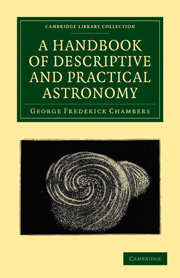Book contents
- Frontmatter
- PREFACE
- SUPPLEMENT
- Contents
- LIST OF ILLUSTRATIONS
- PRINCIPAL AUTHORITIES
- Errata
- A Handbook of Descriptive and Practical Astronomy
- BOOK I A SKETCH OF THE SOLAR SYSTEM
- CHAPTER I THE SUN
- CHAPTER II THE PLANETS
- CHAPTER III VULCAN
- CHAPTER IV MERCURY
- CHAPTER V VENUS
- CHAPTER VI THE EARTH
- CHAPTER VII THE MOON
- CHAPTER VIII MARS
- CHAPTER IX THE MINOR PLANETS
- CHAPTER X JUPITER
- CHAPTER XI SATURN
- CHAPTER XII URANUS
- CHAPTER XIII NEPTUNE
- BOOK II ECLIPSES AND THEIR ASSOCIATED PHENOMENA
- BOOK X METEORIC ASTRONOMY
- APPENDICES
- INDEX TO SUBJECTS
- INDEX TO NAMES
- Plate section
CHAPTER IX - THE MINOR PLANETS
Published online by Cambridge University Press: 05 July 2011
- Frontmatter
- PREFACE
- SUPPLEMENT
- Contents
- LIST OF ILLUSTRATIONS
- PRINCIPAL AUTHORITIES
- Errata
- A Handbook of Descriptive and Practical Astronomy
- BOOK I A SKETCH OF THE SOLAR SYSTEM
- CHAPTER I THE SUN
- CHAPTER II THE PLANETS
- CHAPTER III VULCAN
- CHAPTER IV MERCURY
- CHAPTER V VENUS
- CHAPTER VI THE EARTH
- CHAPTER VII THE MOON
- CHAPTER VIII MARS
- CHAPTER IX THE MINOR PLANETS
- CHAPTER X JUPITER
- CHAPTER XI SATURN
- CHAPTER XII URANUS
- CHAPTER XIII NEPTUNE
- BOOK II ECLIPSES AND THEIR ASSOCIATED PHENOMENA
- BOOK X METEORIC ASTRONOMY
- APPENDICES
- INDEX TO SUBJECTS
- INDEX TO NAMES
- Plate section
Summary
Between the orbits of Mars and Jupiter there is a wide interval, which, until the present century, was not known to be occupied by any planet. The researches of late years, as previously intimated in Chapter II., have led to the discovery of a numerous group of small bodies revolving round the Sun, which are known as the Minor Planets, and which have received names taken chiefly from the mythology of ancient Greece and Rome.
The planets differ in some respects from the other members of the system, especially in point of size, the largest being probably not more than 200 or 300 miles m diameter. Their orbits are also much more inclined, as a general rule, than the orbits of the older planets, whence they are sometimes termed the ultra-zodiacal planets.
The following is a list of these planets, together with the chief elements of their orbits:—
It is needless to give any detailed account of each, but a short summary may not be out of place.
The nearest to the Sun is Flora, which revolves round that luminary in 1193 days or 3¼ years, at a mean distance of 209,819,000 miles.
The most distant is Maximiliana, whose period is 2343 days or 6.4 years, and whose mean distance is 329,000,000 miles.
- Type
- Chapter
- Information
- A Handbook of Descriptive and Practical Astronomy , pp. 51 - 58Publisher: Cambridge University PressPrint publication year: 2010First published in: 1861

